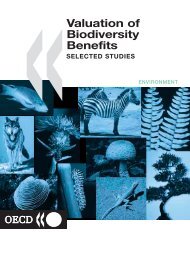Create successful ePaper yourself
Turn your PDF publications into a flip-book with our unique Google optimized e-Paper software.
Article 68<br />
Template-blocking PCR: an advanced PCR technique<br />
for genome walking<br />
Anal Biochem. 2010 Mar; 398(1):112-6.<br />
Bae JH, Sohn JH *<br />
* Correspondence: sohn4090@kribb.re.kr<br />
Industrial Biotechnology & Bioenergy Research Center<br />
This article describes the development of an improved method<br />
for the isolation of genomic fragments adjacent to a known<br />
DNA sequence based on a cassette ligation-mediated polymerase<br />
chain reaction (PCR) technique. To reduce the nonspecific<br />
amplification of PCR-based genome walking, the<br />
3' ends of the restriction enzyme-digested genomic DNA<br />
fragments were blocked with dideoxynucleoside triphosphate<br />
(ddNTP) and ligated with properly designed cassettes. The<br />
modified genomic DNA fragments flanked with cassettes<br />
were used as a template for the amplification of a target<br />
gene with a gene-specific primer (GSP) and a cassette primer<br />
(CP). The ddNTP blocking of the genomic DNA ends significantly<br />
reduced the nonspecific amplification and resulted<br />
in a simple and rapid walking along the genome. The efficiency<br />
of the template-blocking PCR method was confirmed<br />
by a carefully designed control experiment. The method was<br />
successfully applied for the cloning of the PGK1 promoter<br />
from Pichia ciferrii and two novel cellulase genes from<br />
Penicillium sp.<br />
PMID: 19903447<br />
Keywords: Cassette ligation-mediated PCR; Cellulase;<br />
Chromosome walking; Dideoxynucleosides;<br />
Genome walking; Genomics; Phosphoglycerate<br />
kinase; Template-blocking PCR<br />
Article 69<br />
Genome-wide screening and identification of factors<br />
affecting the biosynthesis of prodigiosin by<br />
Hahella chejuensis, using Escherichia coli as a<br />
surrogate host<br />
Appl Environ Microbiol. 2010 Mar; 76(5):1661-8.<br />
Kwon SK, Park YK, Kim JF *<br />
* Correspondence: jfk@kribb.re.kr<br />
Industrial Biotechnology & Bioenergy Research Center<br />
A marine bacterium, Hahella chejuensis, recently has attracted<br />
attention due to its lytic activity against a red-tide<br />
dinoflagellate. The algicidal function originates from its red<br />
pigment, prodigiosin, which also exhibits immunosuppressive<br />
or anticancer activity. Genome sequencing<br />
and functional analysis revealed a gene set contained in<br />
the hap gene cluster that is responsible for the biosynthesis<br />
of prodigiosin. To screen for the factors affecting the prodigiosin<br />
biosynthesis, we constructed a plasmid library of the<br />
H. chejuensis genomic DNA, introduced it into Escherichia<br />
coli strains harboring the hap cluster, and observed changes<br />
in production of the red pigment. Among the screened clones,<br />
hapXY genes whose products constitute a two-component<br />
signal transduction system were elucidated as positive regulators<br />
of the pigment production. In addition, an Hfq-dependent,<br />
noncoding region located at one end of the hap cluster<br />
was confirmed to play roles in regulation. Identification of<br />
factors involved in the regulation of prodigiosin biosynthesis<br />
should help in understanding how the prodigiosin-biosynthetic<br />
pathway is organized and controlled and also aid<br />
in modulating the overexpression of prodigiosin in a heterologous<br />
host, such as E. coli, or in the natural producer, H.<br />
chejuensis.<br />
PMID: 20038694<br />
Keywords: Biosynthetic pathways; DNA, bacterial;<br />
Escherichia coli; Gammaproteobacteria; Gene<br />
library; Genes, bacterial; Molecular sequence data;<br />
Multigene family; Plasmids; Prodigiosin<br />
2010 KRIBB Article Abstracts | 41 |












